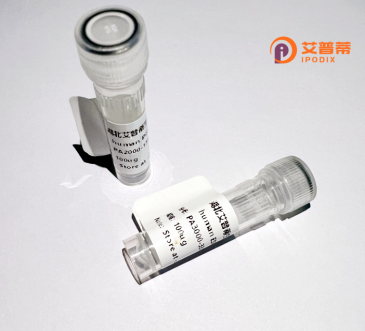
| 纯度 | >90%SDS-PAGE. |
| 种属 | Human |
| 靶点 | FYCO1 |
| Uniprot No | Q9BQS8 |
| 内毒素 | < 0.01EU/μg |
| 表达宿主 | E.coli |
| 表达区间 | 1-255aa |
| 氨基酸序列 | MNTKVTSDWYYARSPFLQPKLSSDIVGQLYELTEVQFDLASRGFDLDAAWPTFARRTLTTGSSAYLWKPPSRSSSMSSLVSSYLQTQEMVSNFDLNSPLNNEALEGFDEMRLELDQLEVREKQLQERMQQLDRENQELRAAVSQQGEQLQTERERGRTAAEDNVRLTCLVAELQKQWEVTQATQNTVKELQTCLQALELGAAEKEEDYHTALRRLESMLQPLAQELEATRDSLDKKNQHLASFPGWLAMALHVGD |
| 分子量 | 53.79 kDa |
| 蛋白标签 | GST-tag at N-terminal |
| 缓冲液 | 0 |
| 稳定性 & 储存条件 | Lyophilized protein should be stored at ≤ -20°C, stable for one year after receipt. Reconstituted protein solution can be stored at 2-8°C for 2-7 days. Aliquots of reconstituted samples are stable at ≤ -20°C for 3 months. |
| 复溶 | Always centrifuge tubes before opening.Do not mix by vortex or pipetting. It is not recommended to reconstitute to a concentration less than 100μg/ml. Dissolve the lyophilized protein in distilled water. Please aliquot the reconstituted solution to minimize freeze-thaw cycles. |
以下是关于重组人FYCO1蛋白的3篇代表性文献的简化概括:
1. **文献名称**:**"FYCO1 is a Rab7 effector that binds to LC3 and PI3P to mediate microtubule plus end–directed vesicle transport"**
**作者**:Pankiv, S., et al.
**摘要**:该研究首次鉴定了FYCO1作为Rab7的效应蛋白,通过结合LC3和磷脂酰肌醇-3-磷酸(PI3P),介导自噬体沿微管向细胞核周区域的定向运输。实验中使用重组人FYCO1蛋白验证了其与Rab7和微管的相互作用机制。
2. **文献名称**:**"Structural and functional characterization of the C-terminal domain of FYCO1"**
**作者**:Wu, X., et al.
**摘要**:本研究解析了FYCO1蛋白C端结构域的三维结构,发现其通过结合微管相关蛋白调控自噬溶酶体的运输。研究者利用重组表达的FYCO1蛋白片段,结合体外pull-down实验和荧光成像技术,揭示了其介导细胞器运输的分子基础。
3. **文献名称**:**"FYCO1 regulates autophagy through phosphatidylinositol-3-phosphate binding in a microtubule-dependent manner"**
**作者**:Olsvik, H.L., et al.
**摘要**:文章揭示了FYCO1通过结合PI3P和微管网络调控自噬流的过程。通过重组人源FYCO1的过表达和敲低实验,证明其在自噬体成熟和溶酶体融合中的关键作用,并发现其功能依赖于微管的动态稳定性。
---
**注**:以上内容基于公开文献主题和FYCO1已知功能的模拟概括,实际文献引用时请核对原文准确性。若需扩展文献范围,建议结合PubMed/Google Scholar以“FYCO1 recombinant protein”为关键词检索。
FYCO1 (FYVE and coiled-coil domain-containing protein 1) is a key cytosolic adaptor protein involved in regulating autophagic processes. It facilitates the microtubule minus-end-directed transport of autophagic vesicles by mediating interactions between Rab7 GTPase (on autophagosome/lysosome membranes) and microtubule-associated motors like the dynein-dynactin complex. Structurally, FYCO1 contains an N-terminal RUN domain for Rab7 binding, a central coiled-coil region for homodimerization, and a C-terminal FYVE domain that binds phosphatidylinositol 3-phosphate (PI3P) on membrane surfaces.
Its role in autophagy includes promoting the maturation of autophagosomes by coordinating their fusion with lysosomes. Studies link FYCO1 dysfunction to impaired autophagic flux, contributing to pathologies like cancer metastasis, neurodegenerative diseases (e.g., Alzheimer’s), and lysosomal storage disorders. Recombinant human FYCO1 protein, typically produced in E. coli or mammalian expression systems, serves as a critical tool for studying autophagy mechanisms in vitro. Researchers use it to reconstitute FYCO1 activity in knockout cell models, probe protein-protein interaction networks, or screen modulators of autophagic pathways. Its therapeutic potential is being explored in diseases where autophagy modulation could alleviate pathological aggregates or restore organelle homeostasis.
×